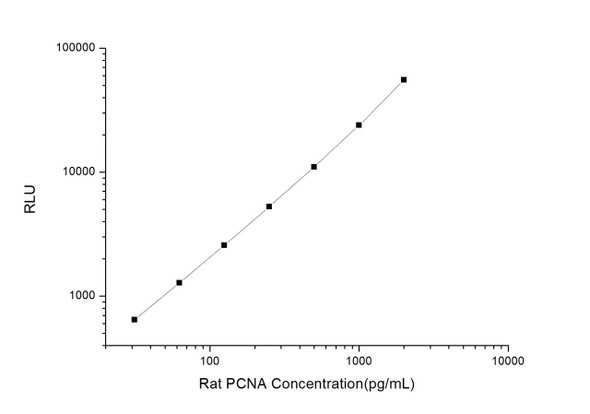Rat PCNA (Proliferating Cell Nuclear Antigen) ELISA Kit (RTES00651)
- SKU:
- RTES00651
- Product Type:
- ELISA Kit
- Size:
- 96 Assays
- Uniprot:
- P04961
- Sensitivity:
- 0.09ng/mL
- Range:
- 0.16-10ng/mL
- ELISA Type:
- Sandwich
- Reactivity:
- Rat
- Sample Type:
- Serum, plasma and other biological fluids
- Research Area:
- Epigenetics and Nuclear Signaling
Description
Rat PCNA (Proliferating Cell Nuclear Antigen) ELISA Kit
The Rat PCNA (Proliferating Cell Nuclear Antigen) ELISA Kit is specifically designed for the accurate quantification of PCNA levels in rat serum, plasma, and cell culture supernatants. This kit boasts high sensitivity and specificity, ensuring precise and reproducible results for a variety of research applications.PCNA is a key protein involved in cell proliferation, DNA synthesis, and repair processes. It plays a crucial role in regulating cell cycle progression and is a widely recognized marker of cellular proliferation.
As such, monitoring PCNA levels can provide valuable insights into cell growth, differentiation, and response to various stimuli.With its advanced technology and user-friendly protocol, the Rat PCNA ELISA Kit offers researchers a powerful tool for studying cell dynamics, evaluating drug efficacy, and investigating disease mechanisms. Trust in this kit to deliver reliable and accurate data for your experimental needs.
| Assay type: | Sandwich |
| Format: | 96T |
| Assay time: | 4.5h |
| Reactivity: | Rat |
| Detection Method: | Colormetric |
| Detection Range: | 0.16-10 ng/mL |
| Sensitivity: | 0.10 ng/mL |
| Sample Volume Required Per Well: | 100µL |
| Sample Type: | Serum, plasma and other biological fluids |
| Specificity: | This kit recognizes Rat PCNA in samples. No significant cross-reactivity or interference between Rat PCNA and analogues was observed. |
This ELISA kit uses Sandwich-ELISA as the method. The micro ELISA plate provided in this kit has been pre-coated with an antibody specific to Rat PCNA. Standards or samples are added to the appropriate micro ELISA plate wells and combined with the specific antibody. Then a biotinylated detection antibody specific for Rat PCNA and Avidin-Horseradish Peroxidase (HRP) conjugate are added to each micro plate well successively and incubated. Free components are washed away. The substrate solution is added to each well. Only those wells that contain Rat PCNA, biotinylated detection antibody and Avidin-HRP conjugate will appear blue in color. The enzyme-substrate reaction is terminated by adding Stop Solution and the color turns yellow. The optical density (OD) is measured spectrophotometrically at a wavelength of 450 nm ± 2 nm. The OD value is proportional to the concentration of Rat PCNA. The concentration of Rat PCNA in samples can be calculated by comparing the OD of the samples to the standard curve.
| UniProt Protein Function: | PCNA: This protein is an auxiliary protein of DNA polymerase delta and is involved in the control of eukaryotic DNA replication by increasing the polymerase's processibility during elongation of the leading strand. Induces a robust stimulatory effect on the 3'- 5' exonuclease and 3'-phosphodiesterase, but not apurinic- apyrimidinic (AP) endonuclease, APEX2 activities. Has to be loaded onto DNA in order to be able to stimulate APEX2. Homotrimer. Forms a complex with activator 1 heteropentamer in the presence of ATP. Interacts with EXO1, POLH, POLK, DNMT1, ERCC5, FEN1, CDC6 and POLDIP2. Interacts with APEX2; this interaction is triggered by reactive oxygen species and increased by misincorporation of uracil in nuclear DNA. Forms a ternary complex with DNTTIP2 and core histone. Interacts with KCTD10 and PPP1R15A. Interacts with POLD1, POLD3 and POLD4. Interacts with BAZ1B; the interaction is direct. Interacts with HLTF and SHPRH. Interacts with NUDT15. Interaction is disrupted in response to UV irradiation and acetylation. Interacts with p21Cip1/p21(CIP1) and CDT1; interacts via their PIP-box which also recruits the DCX(DTL) complex. Interacts with DDX11. Interacts with EGFR; positively regulates PCNA. Interacts with C12orf48/PARI. Interacts with SMARCAD1. Belongs to the PCNA family. |
| UniProt Protein Details: | Protein type:DNA replication; Cell cycle regulation Cellular Component: cell; centrosome; cyclin-dependent protein kinase holoenzyme complex; cytoplasm; intracellular; nuclear chromosome, telomeric region; nuclear lamina; nuclear replication fork; nucleoplasm; nucleus; PCNA complex; replication fork Molecular Function:chromatin binding; damaged DNA binding; dinucleotide insertion or deletion binding; DNA polymerase processivity factor activity; enzyme binding; estrogen receptor binding; histone acetyltransferase binding; identical protein binding; MutLalpha complex binding; protein binding; purine-specific mismatch base pair DNA N-glycosylase activity; receptor tyrosine kinase binding; transcription factor binding Biological Process: base-excision repair, gap-filling; bypass DNA synthesis; epithelial cell differentiation; heart development; leading strand elongation; mismatch repair; negative regulation of transcription from RNA polymerase II promoter; positive regulation of deoxyribonuclease activity; positive regulation of DNA repair; positive regulation of DNA replication; replication fork processing; response to cadmium ion; response to estradiol stimulus; response to lipid; response to oxidative stress |
| NCBI Summary: | cell cycle protein that may contribute to the repair of DNA damage and to cell proliferation caused by exposure to pulmonary toxicants; may influence cell survival in ischaemically compromised tissue [RGD, Feb 2006] |
| UniProt Code: | P04961 |
| NCBI GenInfo Identifier: | 129698 |
| NCBI Gene ID: | 25737 |
| NCBI Accession: | P04961. 1 |
| UniProt Related Accession: | P04961 |
| Molecular Weight: | 28,749 Da |
| NCBI Full Name: | Proliferating cell nuclear antigen |
| NCBI Synonym Full Names: | proliferating cell nuclear antigen |
| NCBI Official Symbol: | Pcna |
| NCBI Official Synonym Symbols: | PCNAR; Pcna/cyclin |
| NCBI Protein Information: | proliferating cell nuclear antigen |
| UniProt Protein Name: | Proliferating cell nuclear antigen |
| UniProt Synonym Protein Names: | Cyclin |
| Protein Family: | PCNA-associated factor |
| UniProt Gene Name: | Pcna |
| UniProt Entry Name: | PCNA_RAT |
As the OD values of the standard curve may vary according to the conditions of the actual assay performance (e. g. operator, pipetting technique, washing technique or temperature effects), the operator should establish a standard curve for each test. Typical standard curve and data is provided below for reference only.
| Concentration (ng/mL) | O.D | Average | Corrected |
| 10 | 2.308 2.314 | 2.311 | 2.248 |
| 5 | 1.613 1.627 | 1.62 | 1.557 |
| 2.5 | 0.884 0.846 | 0.865 | 0.802 |
| 1.25 | 0.403 0.441 | 0.422 | 0.359 |
| 0.63 | 0.227 0.203 | 0.215 | 0.152 |
| 0.32 | 0.161 0.157 | 0.159 | 0.096 |
| 0.16 | 0.111 0.115 | 0.113 | 0.05 |
| 0 | 0.054 0.072 | 0.063 | -- |
Precision
Intra-assay Precision (Precision within an assay): 3 samples with low, mid range and high level Rat PCNA were tested 20 times on one plate, respectively.
Inter-assay Precision (Precision between assays): 3 samples with low, mid range and high level Rat PCNA were tested on 3 different plates, 20 replicates in each plate.
| Intra-assay Precision | Inter-assay Precision | |||||
| Sample | 1 | 2 | 3 | 1 | 2 | 3 |
| n | 20 | 20 | 20 | 20 | 20 | 20 |
| Mean (ng/mL) | 0.48 | 1.55 | 3.80 | 0.48 | 1.61 | 4.12 |
| Standard deviation | 0.03 | 0.07 | 0.12 | 0.03 | 0.10 | 0.17 |
| C V (%) | 6.25 | 4.52 | 3.16 | 6.25 | 6.21 | 4.13 |
Recovery
The recovery of Rat PCNA spiked at three different levels in samples throughout the range of the assay was evaluated in various matrices.
| Sample Type | Range (%) | Average Recovery (%) |
| Serum (n=5) | 89-105 | 96 |
| EDTA plasma (n=5) | 93-108 | 99 |
| Cell culture media (n=5) | 83-97 | 90 |
Linearity
Samples were spiked with high concentrations of Rat PCNA and diluted with Reference Standard & Sample Diluent to produce samples with values within the range of the assay.
| Serum (n=5) | EDTA plasma (n=5) | Cell culture media (n=5) | ||
| 1:2 | Range (%) | 94-110 | 85-100 | 93-105 |
| Average (%) | 100 | 91 | 99 | |
| 1:4 | Range (%) | 93-107 | 80-94 | 83-93 |
| Average (%) | 99 | 86 | 88 | |
| 1:8 | Range (%) | 86-101 | 84-97 | 88-102 |
| Average (%) | 93 | 91 | 94 | |
| 1:16 | Range (%) | 91-105 | 86-100 | 87-99 |
| Average (%) | 98 | 93 | 92 |
An unopened kit can be stored at 4°C for 1 month. If the kit is not used within 1 month, store the items separately according to the following conditions once the kit is received.
| Item | Specifications | Storage |
| Micro ELISA Plate(Dismountable) | 8 wells ×12 strips | -20°C, 6 months |
| Reference Standard | 2 vials | |
| Concentrated Biotinylated Detection Ab (100×) | 1 vial, 120 µL | |
| Concentrated HRP Conjugate (100×) | 1 vial, 120 µL | -20°C(shading light), 6 months |
| Reference Standard & Sample Diluent | 1 vial, 20 mL | 4°C, 6 months |
| Biotinylated Detection Ab Diluent | 1 vial, 14 mL | |
| HRP Conjugate Diluent | 1 vial, 14 mL | |
| Concentrated Wash Buffer (25×) | 1 vial, 30 mL | |
| Substrate Reagent | 1 vial, 10 mL | 4°C(shading light) |
| Stop Solution | 1 vial, 10 mL | 4°C |
| Plate Sealer | 5 pieces | |
| Product Description | 1 copy | |
| Certificate of Analysis | 1 copy |
- Set standard, test sample and control (zero) wells on the pre-coated plate and record theirpositions. It is recommended to measure each standard and sample in duplicate. Note: addall solutions to the bottom of the plate wells while avoiding contact with the well walls. Ensuresolutions do not foam when adding to the wells.
- Aliquot 100µl of standard solutions into the standard wells.
- Add 100µl of Sample / Standard dilution buffer into the control (zero) well.
- Add 100µl of properly diluted sample (serum, plasma, tissue homogenates and otherbiological fluids) into test sample wells.
- Cover the plate with the sealer provided in the kit and incubate for 90 min at 37°C.
- Aspirate the liquid from each well, do not wash. Immediately add 100µL of BiotinylatedDetection Ab working solution to each well. Cover the plate with a plate seal and gently mix. Incubate for 1 hour at 37°C.
- Aspirate or decant the solution from the plate and add 350µL of wash buffer to each welland incubate for 1-2 minutes at room temperature. Aspirate the solution from each well andclap the plate on absorbent filter paper to dry. Repeat this process 3 times. Note: a microplatewasher can be used in this step and other wash steps.
- Add 100µL of HRP Conjugate working solution to each well. Cover with a plate seal andincubate for 30 min at 37°C.
- Aspirate or decant the solution from each well. Repeat the wash process for five times asconducted in step 7.
- Add 90µL of Substrate Reagent to each well. Cover with a new plate seal and incubate forapproximately 15 min at 37°C. Protect the plate from light. Note: the reaction time can beshortened or extended according to the actual color change, but not by more than 30min.
- Add 50 µL of Stop Solution to each well. Note: Adding the stop solution should be done inthe same order as the substrate solution.
- Determine the optical density (OD value) of each well immediately with a microplate readerset at 450 nm.









